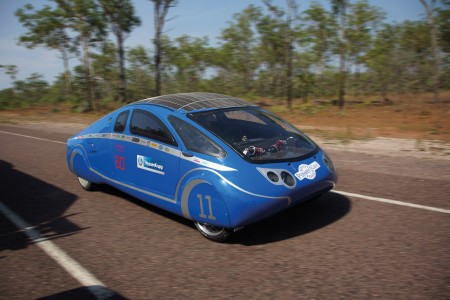Trade press, 2013-09-25, 02:57 pm
PowerCore SunCruiser set for endurance test: Solar car to take part in the World Solar Challenge in Australia starting Sunday
On Sunday, 6th October, the teams will set off from Darwin, Australia in the 2013 World Solar Challenge. Among the starting lineup will be the PowerCore SunCruiser from Bochum University - a new-generation solar-powered high-tech car with a motor featuring electrical steel from ThyssenKrupp.

Challenge for man and machine
This year the car has been entered in a new Cruiser class, for which special regulations apply: The solar car must be able to seat at least two people, and the vehicles must be road legal in their countries of origin. The route along the Stuart Highway, which bisects Australia from north to south, is 3,000 kilometers long. The 63 kilogram batteries of cars in the Cruiser class may only be fully recharged overnight three times, and teams must reach the finishing line in Adelaide no later than Friday. Nine teams from countries such as the Netherlands, the USA, Taiwan, Canada, Japan, New Zealand and Australia will go head to head. Stages of different lengths, defined by the charging points, will ask some serious questions of the team members’ strategic skills. “The very first stage to Tennant Creek will decide who the front runners are going to be. The time limit set by the organizers of two days for a distance of almost 1,000 kilometers means we will have to average almost 60 km/h – a sporting challenge,” says Stefan Spychalski, who has been involved in the solar car project at Bochum University for over ten years. “Our strategists calculate that battery levels could get very low. The dependability of the car will be a vital factor. A breakdown would cost valuable time that would be very difficult to make up again.”
Placings decided by formula
The PowerCore SunCruiser’s final placing will not only be decided by the time the team takes to cover the 3,000 kilometers from Darwin to Adelaide. A formula will also be used to take into account man-kilometers, i.e. the number of people traveling in the car. And the vehicle’s suitability for day-to-day use will also be factored in, as evaluated by experts from the rally organizers. You can follow the race preparations of the only German team on the internet: The PowerCore SunCruiser’s race diary with picture gallery is available online here.
Special material increases motor efficiency
ThyssenKrupp has supported the project from the outset. For the first time, the motor – which can be installed in the front or rear wheels of the vehicle – was made using electrical steel from ThyssenKrupp Steel Europe (Bochum site) and its subsidiary ThyssenKrupp Electrical Steel (Gelsenkirchen site). The material is a special soft magnetic steel used mainly in motors for efficient power transmission. It helps make very efficient use of the sun’s energy from the solar cells with minimal core losses. The natural energy flows directly into the motor or in strong sunshine to the battery, where it is stored for use in dull weather.




